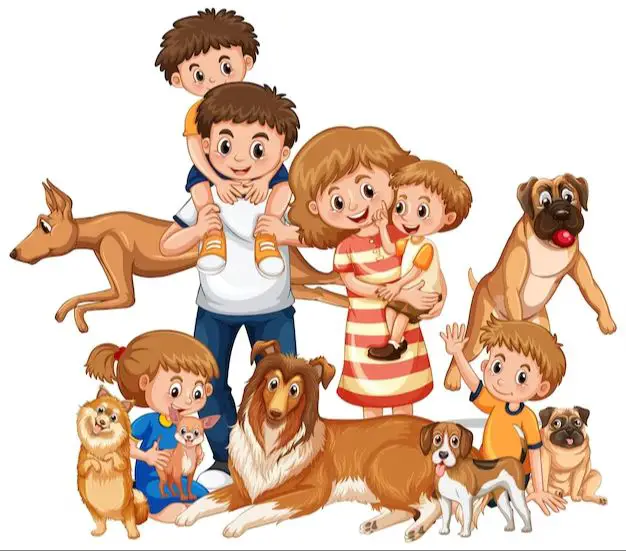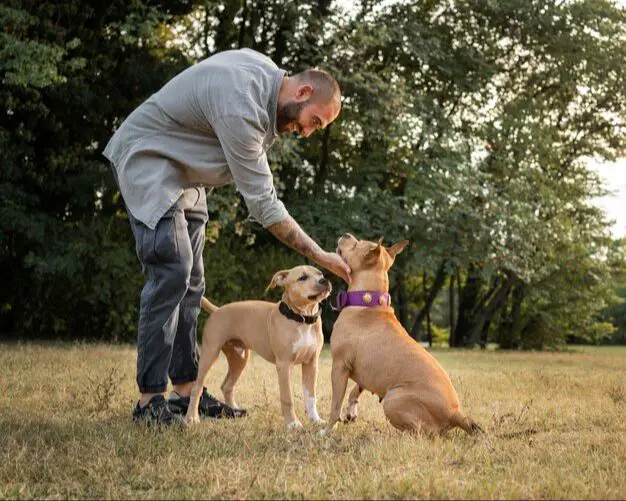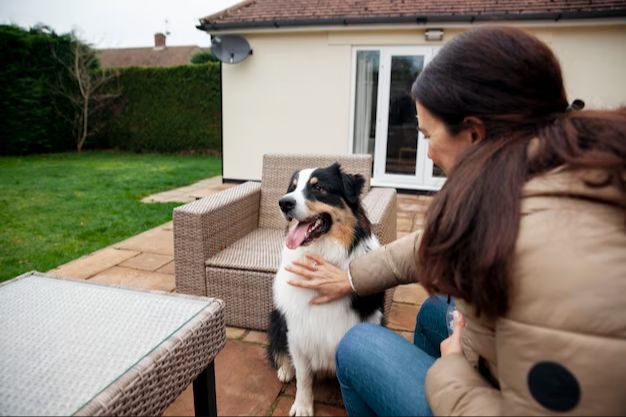What Makes Dogs Compatible
Determining which dogs are compatible with each other comes down to evaluating multiple factors, including size and energy level, breed personality traits, and how your dogs interact when meeting for the first time. It is important to match dogs that have similar behaviors, exercise needs, and share an interest in playing together. Although not guaranteed, dogs of similar size are more likely to get along well, as large size disparities can create safety issues and intimidation. While breed traits are not absolute, they can be useful for predicting potential compatibility. For example, a high energy herding breed may overwhelm a more timid small dog. When introducing new dogs, it is a good sign if they display relaxed body language and mutual playfulness. Play bows, loose wiggly bodies, and taking turns chasing each other are great indicators that the dogs will likely develop positive relationships.
Age Differences
When introducing a new dog into a home, age differences are an important compatibility factor to consider. generally, age differences come into play between puppies and adult dogs, as well as puppies and senior dogs.

Puppies have a lot of energy and require constant supervision, which can overwhelm an adult or senior dog. Adult and senior dogs need peace and quiet, while puppies want to play and explore constantly. The difference in energy levels and needs can cause stress and anxiety for the adult or senior dog.
Puppies also have sharp teeth as they teethe, which can irritate or even harm an older dog during play. Well-intentioned puppy play may be perceived as threatening or bothersome to an older dog.
For these reasons, puppies generally do best with other puppies or younger adult dogs. Introducing a puppy into a home with much older dogs requires careful supervision during interactions and providing separate spaces for the puppy and senior dogs to rest and relax.
With training, socialization, and proper introduction, age gaps can successfully be bridged. But pet owners must be sensitive to the energy and care needs of senior dogs to ensure a smooth transition when bringing a new puppy into the home.
Male and Female Dogs
There are no major differences between male and female dogs when it comes to compatibility. Both male and female dogs can get along well with other dogs of either gender, assuming proper socialization and training.
One consideration with female dogs is that when they come into heat, this can cause behavioral changes and issues with male dogs in the household. An intact male dog may become fixated and territorial over a female in heat. Spaying and neutering your dogs can help avoid this problem.
Overall, male and female compatibility comes down to individual personality, proper introductions, training, and spay/neuter status. Gender alone does not determine how well two dogs will get along and co-exist together.
Multi-Dog Households
Having multiple dogs in one household can work very well when managed properly. Dogs that are raised together from puppyhood tend to get along easily, since they are accustomed to each other from a young age. Proper introductions are key when adding any new dog to a multi-dog home. Go slowly with introductions, keeping the dogs separated at first and allowing carefully supervised interactions until the dogs seem comfortable together.

It’s also important that resources like food, water, toys, and beds are plentiful when keeping multiple dogs, so that competition over these items is minimized. With thoughtful planning, consistency, and proper introductions, a multi-dog household can be very harmonious.
Small and Large Breeds
The size difference between a small dog breed and a large dog breed can impact their compatibility as housemates. Small dogs like Chihuahuas, Yorkies, and Dachshunds weighing less than 10 pounds may become injured if a much larger dog steps on them or plays too roughly.
Additionally, herding breeds like Collies and Australian Shepherds were bred to nip at the heels of livestock to herd them. They may try the same behavior with a small dog, which could frighten or harm a little dog. A 30-pound herding dog chasing a 5-pound Terrier is not a fair match.
To safely have both large and small dogs in the same home, proper training and supervision are essential. The large dog must learn to be gentle and not overwhelm the small dog. And the small dog should have a safe space to retreat to if feeling threatened. With care, big and little dogs can coexist, but their size difference is an important consideration.
High Energy and Low Energy
Dogs have different natural activity levels based on breed, age, and individual personality. Some dogs are extremely high energy and need several hours of vigorous exercise per day. Other dogs are content with a couple short walks. Matching a high energy dog with a more sedentary companion can lead to behavior problems if the high energy dog becomes bored and underexercised.
High energy dogs have an innate need to release their energy. If they don’t get sufficient physical and mental stimulation, they may become destructive by chewing household items, digging up the yard, or barking excessively. On the other hand, lower energy dogs may become fearful or snappy if forced to keep up with an energetic partner. They thrive when their environment remains calm and predictable.
For the highest compatibility, pair dogs with similar energy levels. Watch how they interact during play. An ideal match will have balanced energy where both dogs get tired out at around the same time. If one dog always wants to keep playing while the other loses interest quickly, they are mismatched in terms of their energy needs.
Training and Socialization
One of the most important factors in dog compatibility is proper training and socialization. Well-trained dogs do much better together than untrained dogs. Obedience training teaches dogs important skills like “come,” “stay,” “leave it,” and “settle” which allows them to co-exist peacefully. Additionally, socialization prevents fear and aggression issues. Puppies should be introduced to many sights, sounds, animals, and people in a positive, controlled way during their critical socialization period.

Dogs that know basic obedience cues can be better controlled on walks and during playtime. Owners can call their dogs out of intense situations before things escalate. Training builds respect between owner and dog. It establishes rules and boundaries within the home. Proper training gives owners the tools to redirect inappropriate behaviors like chewing, barking, or rough play.
Socialization prevents dogs from developing fear or aggression towards other dogs. Puppies that meet all kinds of new dogs frequently have less issues as adults. It’s ideal for puppies to go to “puppy preschool” group classes. Adult rescue dogs also benefit greatly from structured socialization to learn good manners and gain confidence around other dogs.
In summary, training and socialization prevents most behavior issues that lead to incompatibility between dogs. It teaches them impulse control, manners, and tolerance for a harmonious multi-dog home.
Breed Personality Traits
Certain inherent traits in some breeds can make them more or less compatible with other dogs. Herding breeds like Collies and Australian Shepherds have a strong herding instinct. They may try to herd or nip at other pets or younger children. Terriers were bred to hunt small vermin. Many don’t do well with smaller pets like hamsters, gerbils, birds, or cats. They have a strong prey drive and may be too much of a temptation.
Hounds love to follow scents and may be more likely to wander off if they pick up an interesting smell. Sighthounds like Greyhounds will instinctively chase anything that runs. Guard dogs like Rottweilers, Dobermans, and German Shepherds are protective and territorial. They require extensive socialization to get along with other dogs and strangers.
High energy sporting breeds like Labrador Retrievers and Golden Retrievers require a lot of activity and exercise. Lower energy companion breeds like French Bulldogs or Pugs may get overwhelmed or stressed by bouncy, energetic dogs that want to play all the time.
Introducing Dogs
When introducing a new dog to a home with an existing dog, it’s important to take things slowly at first. Start by taking the dogs on walks and having play time together while keeping them on leashes. This allows them to get used to each other’s presence and scent while you maintain control.

It’s also a good idea to feed the dogs in separate areas initially. Feed them on opposite sides of the room or in their separate crates. Having their own space for meals prevents any conflicts over food or toys that could arise.
The dogs should also sleep in separate areas in the beginning. Set up their own beds, crates or sleeping spaces away from each other. As they become more comfortable around one another over time, they can gradually spend more time together and share space.
Taking introductions slowly and giving the dogs their own areas early on sets the foundation for a friendly relationship between them down the road. With patience and proper precautions, multiple dogs can learn to coexist happily in one household.
Signs of Incompatibility
When two or more dogs are not compatible with each other, there are clear signs of tension and conflict that will be apparent. Look for the following behaviors that indicate a mismatch:
Fighting/Aggression – This includes growling, baring teeth, stiff body posture, snapping, biting, lunging, or attacking. Any aggressive interaction between dogs is a major red flag. It’s risky and unsafe to keep fighting dogs together.
Fearful Body Language – Subtle signs like cowering, trembling, tail tucking, hiding, or running away can show a dog feels threatened or intimidated by another dog. Their stress hormones will constantly be elevated.
Guarding Food/Toys/Space – When one dog resource guards and shows possessive behaviors around items or locations in the home, it can trigger fights with other dogs. Tension will rise as they compete.
Acting Out – Incompatible dogs may develop problem behaviors like excessive barking, destruction, house soiling, or escaping. These could be signs of anxiety from the conflict and need to be addressed.